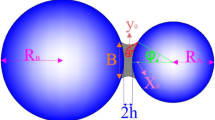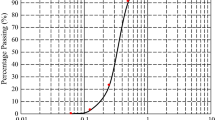Abstract
The simulation of the mechanical behavior of cemented granular material using the discrete element method depends heavily on the bonded contact model. In this study, a three-dimensional discrete element method bond contact model is presented and validated by a series of experimental micromechanical tests on ideal bonded particles (cement-bridged aluminum spheres) subjected to different loading modes. The model uses the cement content and water/cement ratio as parameters affecting the behavior of cemented specimens. The empirical relations between the bonded contact model properties—bond geometry, bond strengths (tensile, compressive, shear, rolling, and torsional strengths) and bond stiffnesses—cement content, water/cement ratio, bonded particle diameter, and particle distance are determined. Discrete element method simulations of drained triaxial tests on cemented specimens are conducted with different cement contents (1, 2, and 3%) and water/cement ratios (0.3, 0.6, 0.9, 1.2, and 1.5) under various confining pressures (100, 300, and 500 kPa) to evaluate the capability of the proposed bonded contact model to predict the mechanical behavior of cemented soils. A comparison between numerical and experimental test results revealed that the bonded contact model can capture the primary mechanical behaviors of these materials (strain softening and dilatancy) with reasonable accuracy by considering two parameters (cement content and water/cement ratio). Microscopically, it is observed that the increase in cement content and the reduction in water/cement ratio increase the maximum inter-particle force magnitude. The number of bonds formed between particles at the beginning and end of the test is affected by the cement content and water/cement ratio.





















Similar content being viewed by others
References
Clough G, Sitar N, Bachus R, Rad N (1981) Cemented sands under static loading. J Geotech Eng Div (ASCE) 107(6):799–817
Coop M, Atkinson J (1993) The mechanics of cemented carbonate sands. Geotechnique 43(1):53–67
Lade P, Overton D (1989) Cementation effects in frictional materials. J Geotech Eng 115:1373–1387
Leroueil S, Vaughan P (1990) The general and congruent effects of structure in natural soils and weak rocks. Geotechnique 40(3):467–488
Airey D (1993) Triaxial testing of naturally cemented carbonate soil. J Geotech Eng (ASCE) 119(9):1379–1398
Huang J, Airey D (1998) Properties of artificially cemented carbonate sand. J Geotech Geoenviron Eng 124(6):492–499
Cuccovillo T, Coop M (1999) On the mechanics of structured sands. Geotechnique 49(6):741–760
Schnaid F, Prietto P, Consoli N (2001) Characterization of cemented sand in triaxial compression. J Geotech Geoenviron Eng 127:857–868
Coop M, Willson S (2003) Behaviour of hydrocarbon reservoir sands and sandstones. J Geotech Geoenviron Eng 129(11):1010–1019
Wang Y, Leung S (2008) Characterization of cemented sand by experimental and numerical investigations. J Geotech Geoenviron Eng 134(7):992–1004
Wang Y, Leung S (2008) A particulate-scale investigation of cemented sand behaviour. Canada Geotech J 45:29–44
Collins B, Sitar N (2011) Stability of steep slopes in cemented sands. J Geotech Geoenviron Eng 137(1):43–51
Rios S, Viana da Fonseca A, Baudet BA (2014) On the shearing behaviour of an artificially cemented soil. Acta Geotech 9:215–226
Amini Y, Hamidi A (2014) Triaxial shear behavior of a cement-treated sand–gravel mixture. J Rock Mech Geotech Eng 6(5):455–465
Hoek E, Martin CD (2014) Fracture initiation and propagation in intact rock—a review. J Rock Mech Geotech Eng 6(4):287–300
Cundall PA (1971) A computer model for simulating progressive, large scale movements in blocky rock systems. In: Proceedings of the international symposium on rock fracture, international society for rock mechanics (ISRM), pp 129–136
Cundall PA, Strack OD (1979) A discrete numerical model for granular assemblies. Geotechnique 29(1):47–65
Potyondy DO, Cundall PA (2004) A bonded-particle model for rock. Int J Rock Mech Min Sci 41(8):1329–1364
Brendel L, Török J, Kirsch R, Bröckel U (2011) A contact model for the yielding of caked granular materials. Granular Matter 13(6):777–786
Obermayr M, Dressler K, Vrettos C, Eberhard P (2013) A bonded-particle model for cemented sand. Comput Geotech 49:299–313
Brown NJ, Chen JF, Ooi JY (2014) A bond model for DEM simulation of cementitious materials and deformable structures. Granular Matter 16(3):299–311
Jiang M, Zhang F, Thornton C (2015) A simple three-dimensional distinct element modeling of the mechanical behavior of bonded sands. Int J Numer Anal Meth Geomech 39(16):1791–1820
Shen Z, Jiang M, Thornton C (2016) DEM simulation of bonded granular material. Part I: contact model and application to cemented sand. Comput Geotech 75:192–209
Mahboubi-Ardakani AR (1995) Contribution à l'étude micromécanique du comportement des matériaux granulaires par homogénéisation et approche numérique. (Doctoral dissertation, Ecully, Ecole centrale de Lyon)
Yoon J (2007) Application of experimental design and optimization to PFC model calibration in uniaxial compression simulation. Int J Rock Mech Min Sci 44(6):871–889
Hanley KJ, O’sullivan C, Oliveira JC, Cronin K, Byrne EP (2011) Application of Taguchi methods to DEM calibration of bonded agglomerates. Powder Technol 210(3):230–240
Johnstone M, Ooi J (2010) Calibration of DEM models using rotating drum and confined compression measurements. In: 6th world congress on particle technology, Nuremberg Germany 2010
Cheng H, Shuku T, Thoeni K, Tempone P, Luding S, Magnanimo V (2019) An iterative Bayesian filtering framework for fast and automated calibration of DEM models. Comput Methods Appl Mech Eng 350:268–294
Pachón-Morales J, Do H, Colin J, Puel F, Perre P, Schott D (2019) DEM modelling for flow of cohesive lignocellulosic biomass powders: Model calibration using bulk tests. Adv Powder Technol 30(4):732–750
Do HQ, Aragón AM, Schott DL (2018) A calibration framework for discrete element model parameters using genetic algorithms. Adv Powder Technol 29(6):1393–1403
Wang Y, Tonon F (2009) Modeling Lac du Bonnet granite using a discrete element model. Int J Rock Mech Min Sci 46(7):1124–1135
Wang Y, Tonon F (2010) Calibration of a discrete element model for intact rock up to its peak strength. Int J Numer Anal Meth Geomech 34(5):447–469
Qu T, Feng YT, Wang M, Jiang S (2020) Calibration of parallel bond parameters in bonded particle models via physics-informed adaptive moment optimisation. Powder Technol 366:527–536
Jiang M, Liu F, Zhou Y (2014) A bond failure criterion for DEM simulations of cemented geomaterials considering variable bond thickness. Int J Numer Anal Meth Geomech 38(18):1871–1897
Jiang M, Jin S, Shen Z, Liu W, Coop M (2015) Preliminary experimental study on three-dimensional contact behavior of bonded granules. In: International symposium on geohazards and geomechanics (ISGG2015), IOP Conf. Series: Earth and Environmental Science 26–012007
Shen Z, Jiang M, Wan R (2016) Numerical study of inter-particle bond failure by 3D discrete element method. Int J Numer Anal Meth Geomech 40:523–545
Potyondy DO (2015) The bonded-particle model as a tool for rock mechanics research and application: current trends and future directions. Geosyst Eng 18(1):1–28
Feng K, Montoya BM (2016) Influence of confinement and cementation level on the behavior of microbial-induced calcite precipitated sands under monotonic drained loading. J Geotech Geoenvironm Eng 142(1):4015–4057
Yang P, O’Donnell S, Hamdan N, Kavazanjian E, Neithalath N (2017) 3D DEM simulations of drained triaxial compression of sand strengthened using microbially induced carbonate precipitation. Int J Geomech 17(6):1–12
Kavazanjian E, O’Donnell S, Hamdan N (2015) Biogeotechnical mitigation of earthquake-induced soil liquefaction by denitrification: A two stage process. In: 6th international conference on earthquake geotechnical engineering, The conference company New Zealand, Christchurch, New Zealand
O'Donnell S (2016) Mitigation of earthquake-induced soil liquefaction via microbial denitrification: A two-stage process. PhD Dissertation. Arizona State University
Wang W, Pan J, Jin F (2019) Mechanical behavior of cemented granular aggregates under uniaxial compression. J Mater Civ Eng 31(5):1–10
Willett CD, Adams MJ, Johnson SA, Seville JP (2000) Capillary bridges between two spherical bodies. Langmuir 16(24):9396–9405
El Shamy U, Gröger T (2008) Micromechanical aspects of the shear strength of wet granular soils. Int J Numer Anal Meth Geomech 32(14):1763–1790
Chen Y, Zhao Y, Gao H, Zheng J (2011) Liquid bridge force between two unequal-sized spheres or a sphere and a plane. Particuology 9(4):374–380
Scholtès L, Nicot BCF, Darve F (2012) Discrete modelling of capillary mechanisms in multi-phase granular media. http://arxiv.org/abs/1203.1234
Liu K, Yin J H, Chen WB, Feng WQ, Zhou C (2020) The stress–strain behaviour and critical state parameters of an unsaturated granular fill material under different suctions. Acta Geotechnica, 1–16
Wang M, Pande GN, Pietruszczak S, Zeng ZX (2020) Determination of strain-dependent soil water retention characteristics from gradation curve. J Rock Mech Geotech Eng 12(6):1356–1360
Lian G, Thornton C, Adams M (1993) A theoretical study of the liquid bridge forces between two rigid spherical bodies. J Colloid Interface Sci 161(1):138–147
Krenzer K, Mechtcherine V, Palzer U (2019) Simulating mixing processes of fresh concrete using the discrete element method (DEM) under consideration of water addition and changes in moisture distribution. Cem Concr Res 115:274–282
de Bono J, McDowell G, Wanatowski D (2012) Modelling cemented sand using DEM. In: Proceedings of 2nd international conference on transportation geotechnics (ICTG)
de Bono J, McDowell G, Wanatowski D (2015) Investigating the micro mechanics of cemented sand using DEM. Int J Numer Anal Meth Geomech 39(6):655–675
Tang Y, Xu G, Lian J, Yan Y, Fu D, Sun W (2019) Research on simulation analysis method of microbial cemented sand based on discrete element method. Adv Mater Sci Eng, 2019:1–18 https://doi.org/10.1155/2019/7173414
Coulomb CA (1776) Essai sur une application des regles des Maximis et Minimis a quelques problemes de Statique relatifs a l'Architecture. Memoirs Academie Royal Pres. Division Say. 7, Par~s, France (in French)
Ladd RS (1978) Preparing test specimens using undercompaction. Geotech Test J 1:16–23
Itasca Consulting group Inc (2018), Particle flow code in three dimensions (PFC3D). Version 6.00. Minneapolis, USA
Mahboubi AR, Cambou B, Fry JJ (1997) Numerical modelling of the mechanical behavior of non spherical, crushable particles. Powders Grains 97:139–142
Zhou C, Xu C, Karakus M, Shen J (2018) A systematic approach to the calibration of micro-parameters for the flat-jointed bonded particle model. Geomech Eng 16(5):471–482
Asghari E, Toll D, Haeri S (2003) Triaxial behaviour of a cemented gravely sand, Tehran alluvium. Geotech Geol Eng 21(1):1–28
Funding
No funding was received to assist with the preparation of this manuscript.
Author information
Authors and Affiliations
Corresponding author
Ethics declarations
Conflicts of interest
All authors certify that they have no affiliations with or involvement in any organization or entity with any financial interest or non-financial interest in the subject matter or materials discussed in this manuscript.
Additional information
Publisher's Note
Springer Nature remains neutral with regard to jurisdictional claims in published maps and institutional affiliations.
Rights and permissions
Springer Nature or its licensor holds exclusive rights to this article under a publishing agreement with the author(s) or other rightsholder(s); author self-archiving of the accepted manuscript version of this article is solely governed by the terms of such publishing agreement and applicable law.
About this article
Cite this article
Motlagh, N.M., Ardakani, AR.M. & Noorzad, A. Experimental and numerical studies of a three-dimensional bonded contact model of cemented granular soils. Comp. Part. Mech. 10, 445–463 (2023). https://doi.org/10.1007/s40571-022-00502-9
Received:
Revised:
Accepted:
Published:
Issue Date:
DOI: https://doi.org/10.1007/s40571-022-00502-9




